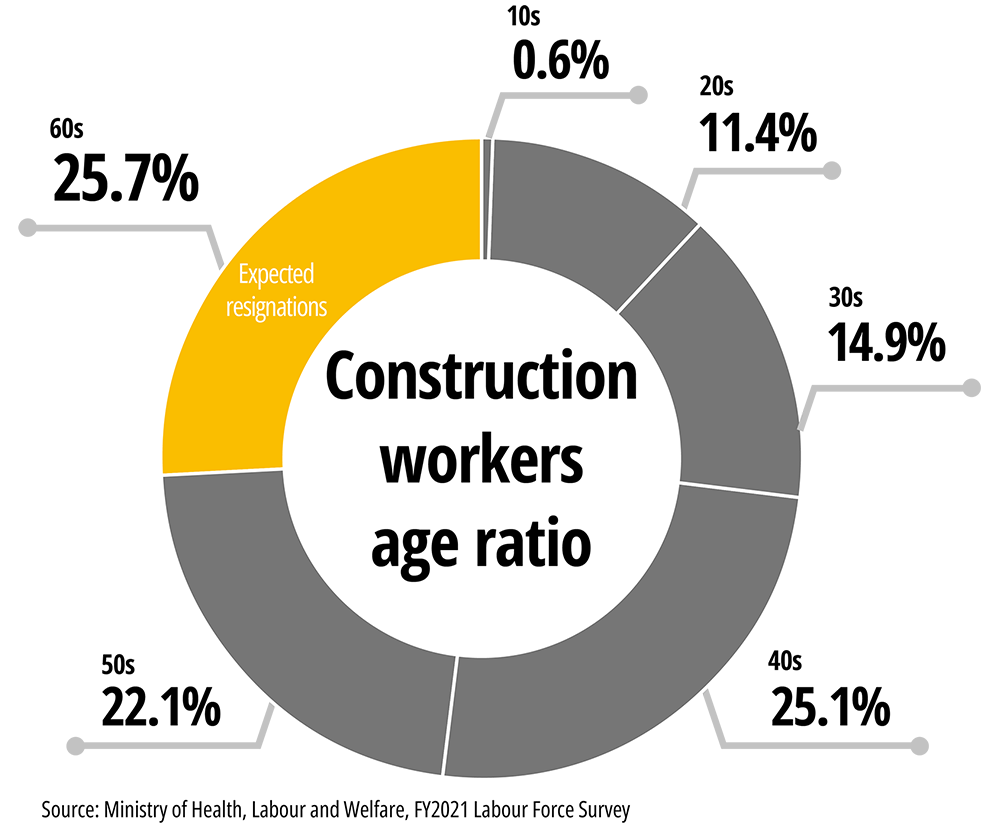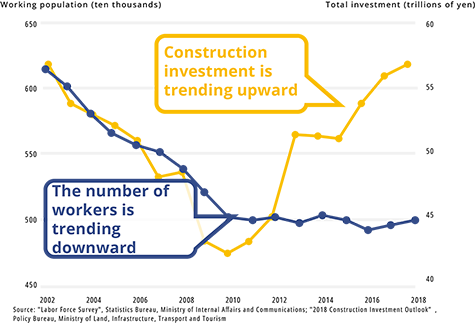 Social Issues We Are Focused On
Social Issues We Are Focused On
Because the labor and business environment is not improving, the employment rate among young people is low, and with more and more people "retiring due to old age" the "chronic labor shortage" in the construction industry is accelerating.
Social issues that the Company is focused on
Industry-wide Challenges

The difficult labor environment in the construction industry
Normally, wages should be adjusted to the level where there is a balance between demand (construction investment) and supply (number of workers), but in the construction industry, despite the chronic labor shortage, the average wages are about 18% lower than the average for all industries. In addition, compared to the average for all industries, annual working hours are 336 hours longer, and the number of annual days worked is 29 days more.

The low birthrate and aging population (decrease in the number of young people)
The aging of construction workers is a significant problem. About a quarter of the total workforce is made up of workers aged 60 and over, and the majority of these workers are expected to retire within the next 10 years. Furthermore, the ratio of workers aged 29 or younger who will sustain the construction industry in the future is about 11% of the total workforce, which makes the securing and training of young workers a pressing issue.

Chronic labor shortage despite steady demand
Since its peak of 6.85 million in 1996, the number of construction workers has continued to decline, while the amount of investment in the construction market, although it halved from 84 trillion yen in 1991 to 42 trillion yen in 2010, has since stabilized at around 60 trillion yen. The result is a chronic shortage of labor.
Challenges faced by craftspeople and sole proprietors
Because of the limited number of suppliers due to the practice of relying on contacts to find and retain work, they can easily be exposed to fluctuations between busy and slow periods, which reduces their ability to negotiate prices. In addition, the absence of standards for evaluating skills makes it difficult to gain better compensation by improving one’s skills.
Due to dependence on specific suppliers,

Those on the order side naturally want to monopolize skilled craftspeople, while the craftspeople themselves are dependent on specific suppliers, so the practice of enclosure is deeply rooted in the industry. Because they are reluctant to seek new suppliers, craftspeople are more vulnerable to the fluctuations between busy and slow periods, and they lack the power to negotiate with existing suppliers.
There are no criteria for evaluating abilities

Because craftspeople gain experience at various sites working for different clients, there is no cross-industry system to uniformly evaluate the skills of individual craftspeople. This is a structural problem that prevents workers from receiving better pay by improving their skills.
Challenges faced by construction companies
Construction companies tend to hang on to their craftspeople, but if the aging of subcontractors leads to a weakening of the construction system, they will have difficulty finding new craftspeople with the skills required, increasing their risk of losing opportunities to win orders.
In addition to problems with securing subcontractors, the number of applicants for permanent positions is also insufficient to meet demand due to the poor image of the construction industry itself as having hard, dirty, and dangerous working conditions. This makes it difficult to attract applicants through conventional recruitment services.
Along with the human factors mentioned above, the recent surge in raw material costs triggered by the COVID-19 pandemic has put further pressure on management.